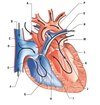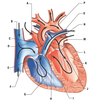overview and function of the cardiovascular system Flashcards
what is the function of the cardiovascular system?
acts as a bulk flow system which transports things around the body
what are examples of things that the cardiovascular system transports around the body?
- oxygen and carbon dioxide
- nutrients
- metabolites
- hormones
- heat
how is the cardiovascular system flexible?
- pump can vary output
- vessels can redirect blood
- vessels can store blood
are pumps in the cardiovascular system in series or parallel and what does this mean?
series - output must be equal (left and right side of the heart)
are vascular beds in series or parallel, and what does this mean?
parallel - all tissues gets oxygenated blood and allows regional redirection of blood
are all vascular beds in parallel?
no, some are in series
what are examples of vascular beds that are in series?
- hypothalamus and anterior pituitary
- gut and the liver
why are some vascular beds in series?
allows blood to flow directly from one place to where it next needs to go, such as carrying nutrients from the gut to the liver
how should the percentage of cardiac output compare to the percentage of oxygen consumption?
they should be about the same

what are examples of organs where the cardiac output and oxygen consumption are not in balance?
- kidneys (more cardiac output than oxygen consumption)
- skin (more cardiac output than oxygen consumption)
- ♡ (more oxygen consumption than cardiac output)
why do the kidneys receive a greater cardiac output than oxygen consumption?
they filter the blood
why does the skin receive a greater cardiac output than oxygen consumption?
thermoregulation, blood is sent there to cool it and maintain body temperature
why does the heart have a greater oxygen consumption than cardiac output?
each time it contracts it cuts of its own blood supply
how can blood be redirected during exercise?
altering the resistance of different vessels

what formula relates flow to pressure and resistance?

how is flow proportional to the difference in pressure?
directly proportional
how is flow proportional to the resistance?
inversely proportional
What is the formula to describe pressure difference?
mean arterial pressure - central venous pressure
what is resistance controlled by?
the radius of a vessel
what is the relationship between resistance and the radius of a vessel?
inversely proportional
resistance = to the radius to the power of 4
what happens to mean arterial pressure during exercise and why?
mean arterial pressure increases due to the heart pumping harder
what does increasing the mean arterial pressure do to the pressure difference between vessels?
increases it
how is blood directed during exercise?
changing the resistance of different vessels
what are examples of different vessles?
- aorta
- arteries
- arterioles
- capillaries
- venules
- veins


















